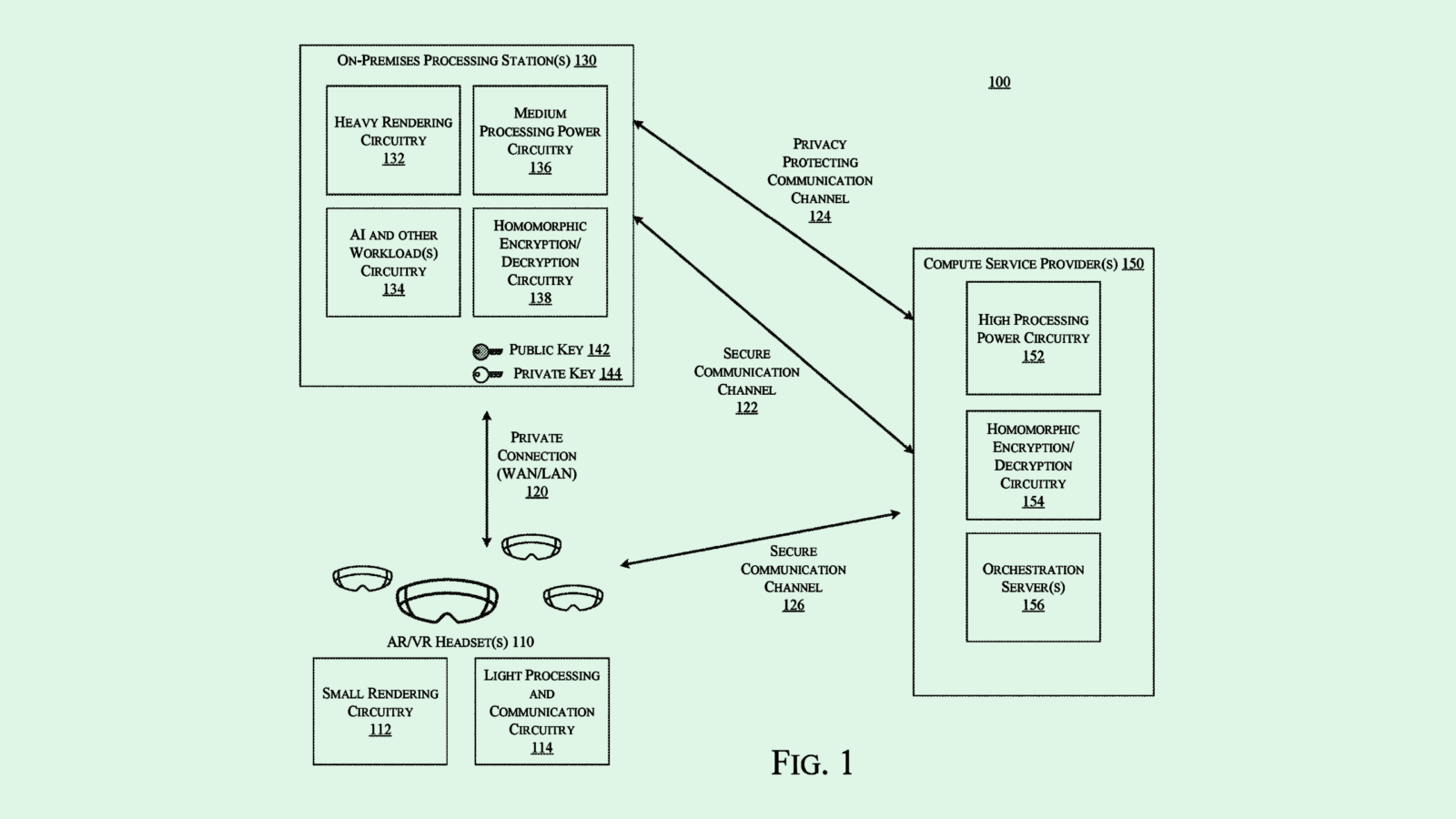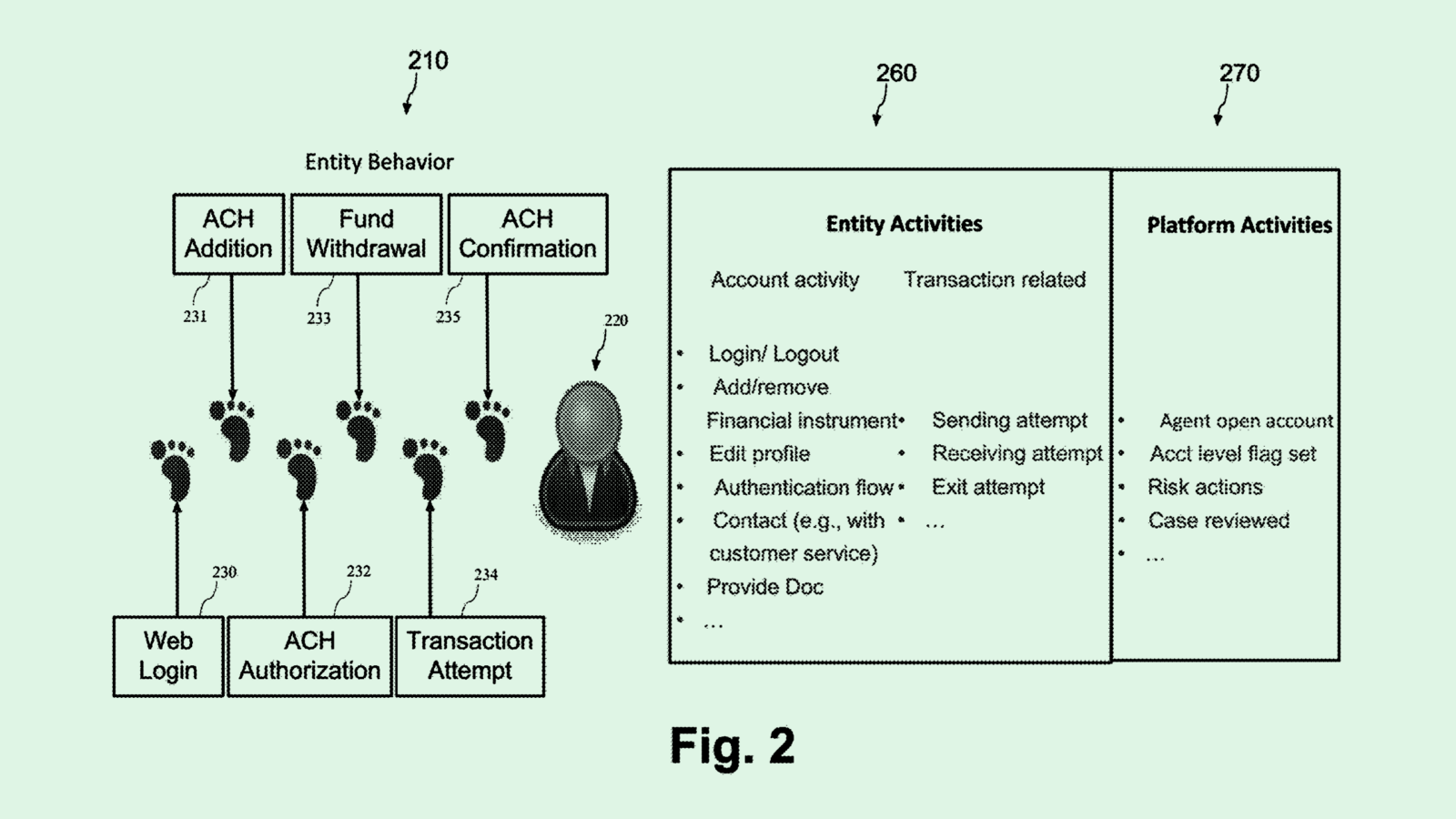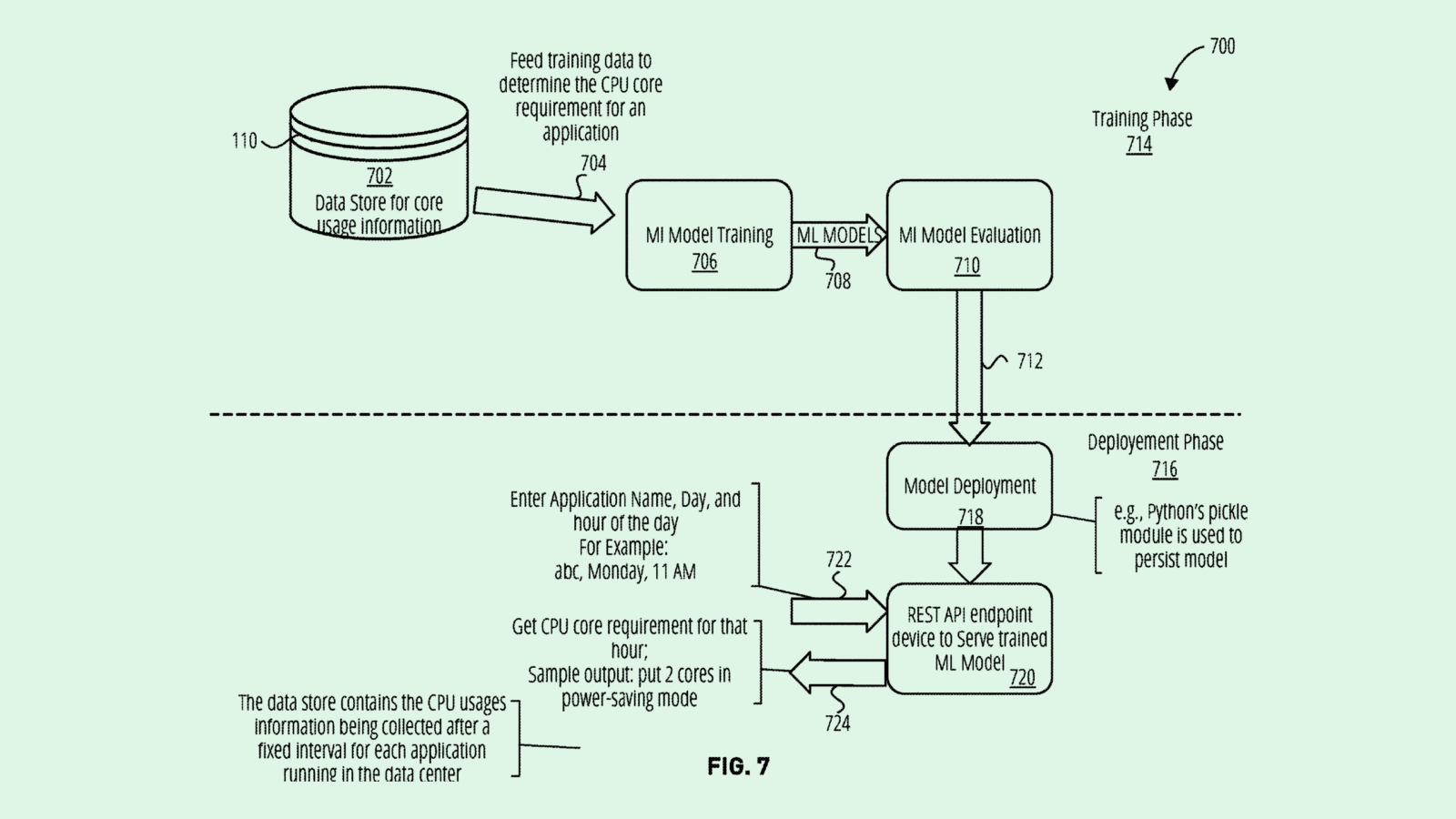Happy Thursday and welcome to Patent Drop!
Today, Intel’s plans to create more private artificial reality highlight the data privacy issues to come with the metaverse and its headsets. Plus: PayPal wants to create AI that tracks all kinds of user behavior, and Nvidia wants to keep data centers from standing idle.
Ahead of today’s Patent Drop, we want to direct you to Persona’s guide to combating identity-related fraud. Fraudsters can slip through the best defenses, but don’t fret — this guide walks you through the steps you should take both right after an attack and in the long term.
Let’s jump in.
Intel’s Eye-Level Privacy
Intel wants to keep your artificial reality experience your own business.
The company is seeking to patent “privacy-preserving augmented and virtual reality” relying on homomorphic encryption. Intel’s tech aims to encrypt the data that’s generated with artificial reality headsets, such as location, image data of user environments, audio data of user voices, or even biometrics like gaze or iris scans.
Artificial reality requires a certain degree of trust from users, Intel noted in the filing. “However, service providers can use the user’s personal data for their own purposes (e.g., sell the data or mine the data). The AR/VR applications may also be the target of cyberattacks that result in data leaks in the worst case.”
Intel’s system seeks to surpass this with homomorphic encryption, which allows the processing of encrypted data without decrypting it and revealing its content. This data is encrypted on the headset before being sent to the service provider, such as the app or program that’s running on the device.
After processing, the information is sent back to the device, where only the user can decrypt it to update their AR or VR experience accordingly. This, Intel noted, “reduces the service provider’s ability to track, spy, and target users, and reduces the risks of data leaks.”
Intel’s investigation into artificial reality privacy doesn’t end there. The company also filed a patent application for “on-premises” AR and VR processing with “privacy preserving infrastructure.” This tech uses audio and video signals in a headset to identify what may be a “sensitive object,” such as speech data, biometrics, or anything personally identifiable.
If that sensitive data is needed for processing or storage on an application running on a headset, Intel’s system prioritizes processing it locally on the device itself. If the data processing is too heavy of a workload for the headset, the sensitive data is instead homomorphically encrypted before being sent to the service provider.

Intel’s patent highlights a major concern amid the growing popularity of artificial reality devices: they collect a lot of personal data, said Calli Schroeder, senior counsel and global privacy counsel at the Electronic Privacy Information Center.
A study from the Stanford Virtual Human Interaction Lab found that 20 minutes in VR could create almost 2 million unique impressions of a user’s body language. Because of this, privacy issues are often “built into the technology itself,” said Schroeder.
“Augmented reality and mixed reality both … have to absorb your real-world environment and sometimes that can include (personal) information,” said Schroeder. “Because you have such a high volume (of data), you’re able to draw really specific inferences from that.”
Not only do these devices present privacy issues for the wearer, but also to anyone in their periphery, Schroeder noted. If you have a roommate, live-in partner, or children, their data automatically becomes part of the scenery picked up by an augmented reality headset. Wearing one of these devices in public, meanwhile, may unwittingly subject bystanders to this data collection, Schroeder noted.
Intel’s patents may offer a solution by automatically encrypting any sensitive data before it even leaves the device – or by selectively keeping private data from leaving the device at all. And if these devices consider the identities of others to be “sensitive objects” mentioned in the filings, that provides a safeguard for those in the surrounding environment.
These privacy sticking points are even more concerning when you consider that practically every big tech company is working on extended reality in some form or fashion, Schroeder said. Meta has long been plugging away at the metaverse, Apple recently released the Vision Pro, Microsoft has the HoloLens, and Google and Samsung are partnering on an offering. “It’s really solidifying an information monopoly in a lot of cases,” Schroeder noted.
Intel, meanwhile, isn’t a force in the extended reality space, having scrapped plans for an all-in-one “merged reality” system called Project Alloy back in 2017. But patents like this could still prove lucrative, allowing it to “corner the market” on extended reality privacy while other tech companies continue to do the opposite.
Download This Free Guide to Combating Identity Fraud
Fraud is not a matter of “if” but “when.” While no business wants to find itself the target of a fraud attack, the simple reality of operating a business online means you’ll likely face this threat eventually.
Additionally, as technology evolves, so do fraudsters. This means you not only need to manage the fraud you’re facing today, but also evolve your strategies to deter the fraud you’ll face tomorrow. Download Persona’s latest guide to learn how to combat fraud in the short and long term, evaluate and evolve your current strategy, and build a flexible process to prevent fraud in the future.
Learn how to react to, detect, and prevent the next iteration of fraud.
PayPal’s Personal Trainer
PayPal wants to train its AI models with a personal touch.
The fintech giant filed a patent application for a way to train a “recurrent neural network” with “behavioral data.” PayPal’s system essentially aims to identify patterns and trends in user behaviors over time via their account data, particularly their transaction history.
Though transaction data is particularly helpful in understanding user trends, “conventional technology is unable to leverage transaction data associated with an entity to predict behavior of the entities,” PayPal said in the filing.
PayPal’s patent lays out a way to do this kind of user analysis and prediction using an “ensemble” of three different AI models, each of which pinpoint a “predetermined behavior” of a certain customer. The filing noted that this ensemble of models can analyze trends in tons of different data, both structured and unstructured, including “human behavior data, textual data, side channel data from processors, information from networks such as social networks and the like.”
First, a user’s “account parameters,” or the hoard of data associated with their profile, is fed into a graphical neural network, or one that’s particularly good at parsing out structured data. The data is then passed to an “autoencoder,” which is good at turning unstructured raw data into something easier to understand. Finally, the last layer is a recurrent neural network, or a model that’s particularly good at analyzing how data changes over time.
The filing listed several different behaviors that this wide-ranging AI may be able to track down, including harmful actions like fraud, the “behavior of high value customers” such as spending on high-end purchases, or actions indicating the likelihood of needing a loan. Long story short: PayPal’s army of AI models can paint an accurate picture of who you are as a consumer.

AI has long been embedded in the fintech space. However, most of these integrations are put to use on the back end, such as in fraud detection. PayPal’s patent history has tons of examples of this, including methods to find anomalies with machine learning and to calculate trust scores of certain user activities.
This patent, however, lays out plans for AI-based tech that can do more than detect something going wrong. This filing pitches a model with the capability to find patterns in just about anything relating to users – whether it be used for loan approval, purchasing trends, or shopping deals.
And PayPal’s fondness for AI extends beyond just patent applications. The company announced a host of new AI-driven products in January that would be released throughout the year, including tools to help merchants better target their customers.
“The data that we have and our ability to actually see what people have bought and know what merchants are trying to target, that’s where I think AI is the huge opportunity for us,” PayPal CEO Alex Chriss told Reuters in an interview.
However, this patent’s core concept of predicting user behavior has also been around “as long as we’ve had data,” said Arun Kumar, executive vice president of data and insights at Hero Digital. What PayPal’s models may offer is a way to use this tracking to potentially create much more value for the individual consumer, Kumar said, bringing AI into the user-end of the fintech space.
But given that personal financial data is some of the most sensitive data that a company can collect, creating fintech products that people actually use requires three things: security, trust and value creation, said Kumar. If a platform is mining data without providing users anything of equivalent value in return or it has security holes, then users simply won’t trust or use it.
“Consumers think a lot about their money – how they spend it, save it, invest it, and manage it,” said Kumar. “The benchmark for consumers handing over all of their personal financial data is creating that value for them.”
Nvidia Shares the Work
Nvidia wants to make sure its servers aren’t wasting energy.
The company wants to patent a system for identifying “idle cores” in data centers using machine learning. Nvidia’s tech uses AI to determine which “cores,” or processing units, are being underutilized, and power them down accordingly.
“It is important to find idle or underutilized computing devices so that the usages of these computing devices can be more efficiently allocated,” Nvidia said. “In the data center or cloud environment, it is important to save power (energy) consumed by a server.”
Essentially, this system uses a machine learning model to monitor servers to see when processing units may be wasting power by idling when they’re not needed. Once identified, Nvidia’s system can put those processors into one of two modes: “power-saving mode” and “performance mode.” If the processor isn’t needed, it’ll go into power-saving.
Additionally, Nvidia’s system can determine when processors may be needed using machine learning-based prediction. This part of the system takes in historical data regarding the energy consumption of different jobs, applications, or tasks completed by these CPUs, and predicts how much energy is going to be used in the future.
The system may do this analysis and prediction at any given point in time – for example, looking at energy usage from one hour to predict the next hour. With these predictions, the system can preemptively put certain processors into power-saving mode, only keeping the exact number needed. If an unexpected uptick in power is needed, the servers can then be kicked back into performance mode.

While data centers and cloud services provide a huge amount of power for developing AI, the reverse is also true, said Trevor Morgan, VP of product at OpenDrives. Machine learning can prove to be incredibly valuable for automating the operation of data centers, especially when it comes to making things as efficient as possible, he said.
“You’re always worried about idle resources and using them — that’s the whole notion of load balancing,” said Morgan. “This (patent) goes in a different direction. This asks, ‘Where can we shut things down in order to have a better consumption of power while still handling the workload?’”
But turning off a few idle processors in one data center won’t save much power. When applied to hundreds of data centers, however, this kind of tech can result in significant energy efficiency, said Morgan. Plus, turning off these processors when they’re not in use can extend their life expectancy, something that may be particularly useful as cloud services and chip demand grows.
A patent like this makes sense for a chip giant like Nvidia. The company’s semiconductors have spread like wildfire throughout data centers, especially amid the AI boom. Its fourth-quarter data center revenue reached $18.4 billion, up 409% from the previous year. Given the amount of energy that data centers tend to suck up, this patent could be a method of solving a problem that its own technology is complicit in – and making more money while doing it.
Extra Drops
- Amazon doesn’t want you stealing code. The company is seeking to patent a machine learning-based system for suggesting code based on software licensing.
- Meta wants to lift the veil between virtual worlds. The company filed a patent application for “doors for artificial reality universe traversal.”
- Microsoft is bringing AI to broadcast news. The company wants to patent systems for a “machine learning driven teleprompter.”
What Else is New?
- Amazon CEO said in his letter to shareholders that the company is looking to cut costs while also doubling down on AI investments.
- Microsoft is launching new AI tools for PC and Cloud in May at its annual Build conference.
- Google parent company Alphabet is on its way to $2 trillion in value as investors remain bullish on the tech giant’s AI strategy.
Patent Drop is written by Nat Rubio-Licht. You can find them on Twitter @natrubio__.
Patent Drop is a publication of The Daily Upside. For any questions or comments, feel free to contact us at patentdrop@thedailyupside.com.

